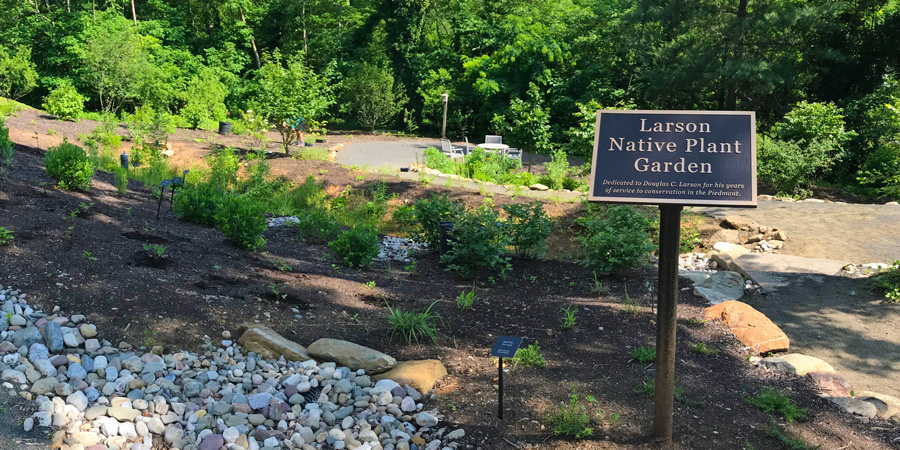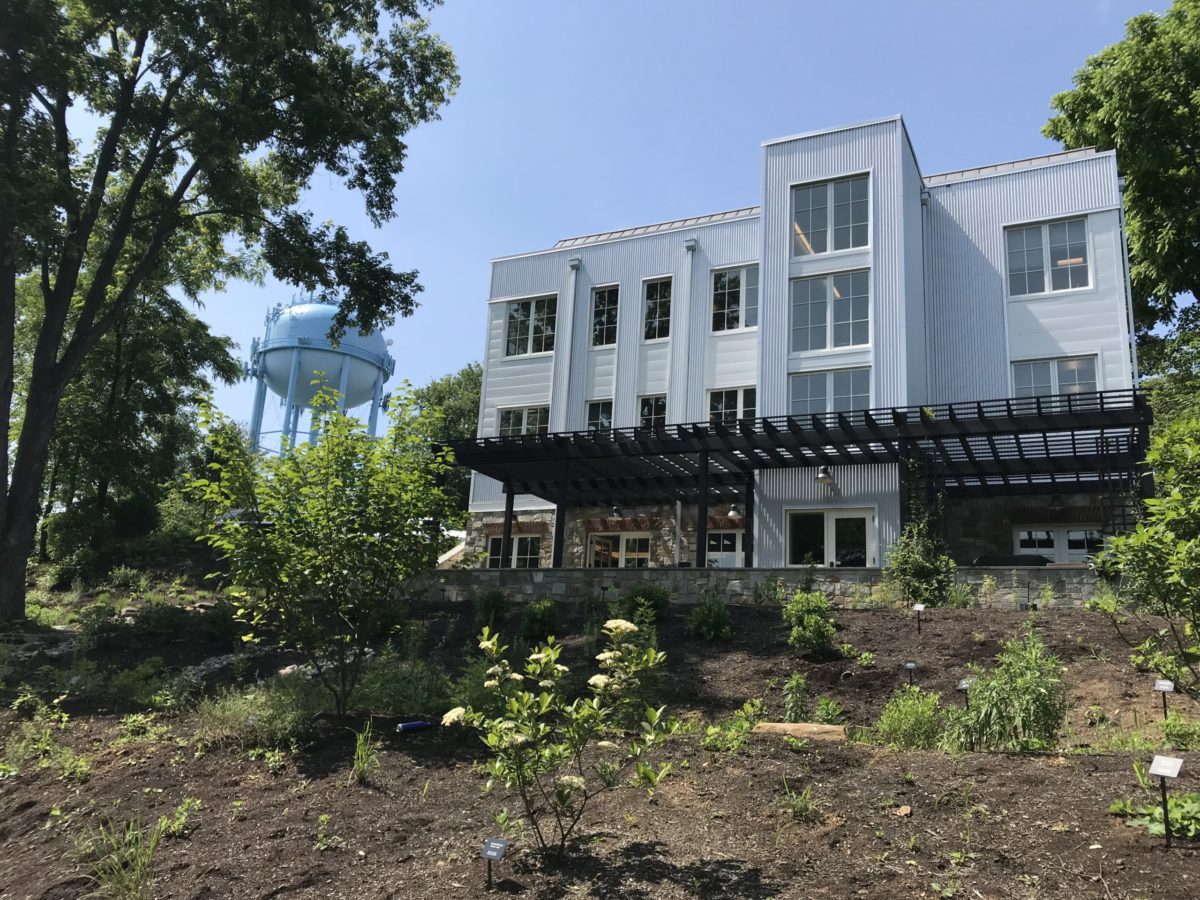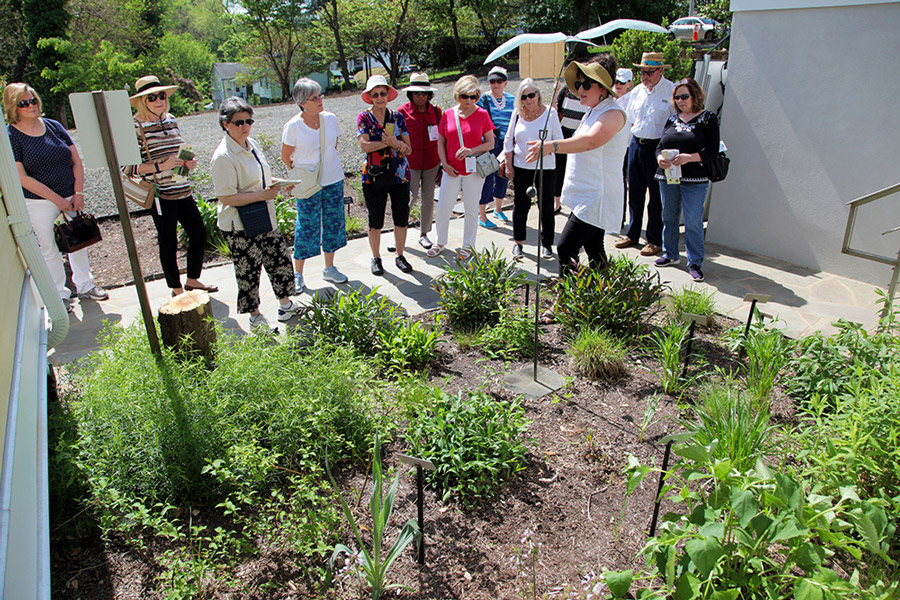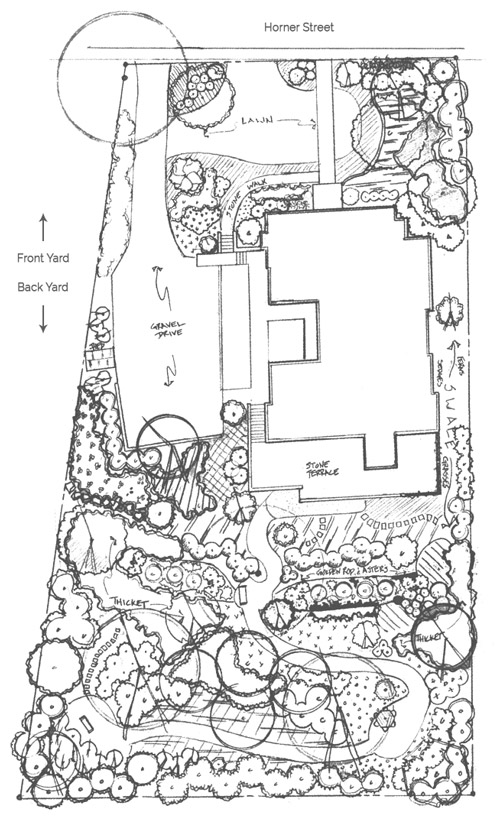A Demonstration Site at PEC’s Warrenton Office

In 2015, PEC finished the renovation and expansion of our historic headquarters office, which was built in 1784 in Warrenton, Virginia. As part of the vision for a more sustainable building, we began extensive restoration work on the office grounds.
Once we completed the building addition, I was anxious to see PEC keep up the momentum and continue with the landscaping. We made such an effort to have the building reflect the organization’s values — from the reuse of an old building, geothermal HVAC system, solar panels, state-of-the art windows and insulation — it was important the landscaping also make a statement that was in keeping with our programmatic goals.
Douglas C. Larson
As of summer 2018, the garden was largely complete, and we are proud to name it in honor of Doug Larson. Doug is a former vice president of PEC, and served in that capacity for 16 years before his retirement in 2016. Thanks to Doug’s passion for natives and dedication to the organization, Piedmont residents have a site that they can visit that demonstrates how native plants can be used in an urban and suburban landscape.
Our office and its surrounding landscape is a demonstration of PEC’s values for a more sustainable future. “We want the land to serve as a showcase for future workshops to educate the public on the use of natives to create backyard habitat,” said Larson.
Since native plants are supposed to be in our local habitat, they use less and provide more. They require less water, and they don’t need pesticides as the plants have developed their own defenses against local pests. Natives also provide food and shelter to local wildlife, which helps build a stronger ecosystem, and in turn keeps the population of undesirable insects like mosquitoes under control, for example.


Visit the Garden
Throughout the year, we host tours and workshops to showcase the garden and show people how native plants can be used in home landscaping. Plant labels with scientific names and bloom periods are installed throughout the garden so people can take note of specific plants they like and use them in their own yards.
**While the garden is not open for public self-guided tours, we do encourage you to stop by our office during business hours so a PEC staff person can show you around. You can also keep your eyes out for a scheduled tour or workshop at pecva.org/events.

The Design

The restoration project has been led by PEC’s very own Celia Vuocolo and Dan Holmes.
Dan Holmes, PEC’s director of state policy, also has a background in horticulture and received his masters in landscape design from the Conway School, a graduate program focused on sustainable landscape planning and design.
“What we’re doing on the grounds of the Warrenton office will be an example of what people can do in their own backyard,” says Dan. “The front of the property was designed with the suburban homeowner in mind. Therefore the design is more traditional, mimicking the residential landscapes we have grown accustomed to in the U.S., but we replaced the ornamental European and Asiatic varieties with native plants.
“In the back, we wanted to be a little more wild. So while there is a definite form, we did our best to recreate habitats we find in wilderness. We are also taking a slow approach to recreate woodlands and edge habitat. We are first establishing shade trees (linden and maples) and flowering understory and edible trees (redbud, dogwoods, paw- paw and persimmon) and seeding the area with sun-loving meadow species. Over time, as the shade trees establish, the area will transition and allow for more shade-loving perennials. Thickets of winterberry and smooth sumac extend up from the woodland area, and the landscape transitions to low-growing, shade-loving perennials closer to our back patio.”
One of the first outdoor implementations was the creation of a pollinator garden, spearheaded by our habitat and stewardship specialist, Celia Vuocolo, who was also responsible for selecting the perennials. Some of the plants include scarlet beebalm, blazing star, garden phlox, swamp milkweed and oxeye sunflower. When in bloom, these flowers have been buzzing with pollinators.
“A lot of people think providing wildlife habitat means working on a large scale, but PEC will be able to demonstrate what can be done in a relatively small space,” says Doug. “I think people feel like they can only plant roses or boxwood bushes, and that the other native ‘wild stuff’ is for people who live in a more rural space. But once you see how beautiful the natives are, you realize how great they actually are for smaller urban spaces. And everyone benefits—residents and wildlife.”
PEC board member and long-time supporter of our organization, Mark Ohrstrom, and the founder of Grelen Nursery, Dan Gregg, generously donated many of the plants to our restoration effort.
Plant List
| Common Name | Cultivar | Scientific Name | Bloom Time |
| Anise hyssop | Agastache foeniculum | Jul-Aug | |
| Nodding onion | Allium cernuum | Jun-Aug | |
| Field pussytoes | Antennaria neglecta | Apr-June | |
| Wild ginger | Asarum canadense | Apr-June | |
| Swamp milkweed | Asclepias incarnata | Jun-Oct | |
| Common milkweed | Asclepias syriaca | Jun-Aug | |
| False yellow indigo | Baptisia sphereocarpa | May-June | |
| Blue wood sedge | Carex flaccosperma | ||
| Fringe tree | Chionanthus virginicus | Apr-May | |
| Summersweet | Clethra alnifolia | Jul-Aug | |
| Mistflower | Conoclinium coelestinum | Jul-Nov | |
| Flowering dogwood | Cornus florida | Mar-May | |
| Poverty oat grass | Danthonia spicata | May-July | |
| Rattlesnake master | Eryngium yuccafolium | May-Aug | |
| Fothergilla | Mt. Airy | Fothergilla | Apr-May |
| Wild hydrangea | Annabelle | Hydrangea arborescens | Jun-Aug |
| Allegheny stonecrop | Hylotelephium telephoides | Aug-Sep | |
| Shrubby St. Johns wort | Hypericum prolificum | Jun-Aug | |
| American holly | Miss Helen | Ilex opaca | Apr-June |
| Sweetspire | Little Henry | Itea virginica | Apr-June |
| Dwarf liatris | Liatris microcephala | Jul-Oct | |
| Prairie blazing star | Liatris pycnostachia | Aug-Dec | |
| Wild bergamot | Monarda fistulosa | May-Sep | |
| Pink muhly grass | Muhlenbergia capillaris | ||
| Switchgrass | Northwind | Panicum virgatum | |
| Wild quinine | Parthenium integrifolium | Jun-July | |
| Small’s penstemon | Penstemon smallii | Apr-June | |
| Beardtongue | Husker Red | Penstemon digitalis | May-June |
| Threadleaf mountain mint | Pycnanthemum tenuifolium | Jun-Sep | |
| Moss phlox | Phlox subulata | Mar-June | |
| Lyreleaf sage | Purple Knockout | Salvia lyrata | Apr-June |
| Three-leaved stonecrop | Sedum ternatum | Apr-June | |
| American senna | Cassia hebercarpa | Jul-Aug | |
| Little bluestem | Standing Ovation | Schizachyrium scoparium | |
| Blue eyed grass | Lucerne | Sisyrinchium angustifolium | Mar-July |
| Sweet goldenrod | Solidago odora | Jul-Oct | |
| Dwarf goldenrod | Golden Fleece | Solidago sphacelata | Jul-Oct |
| Heath aster | Snow Flurries | Symphyotrichum ericoides | Aug-Oct |
| Smooth aster | Bluebird | Symphyotrichum laevis | Aug-Oct |
| Wild blueberry | Duke | Vaccinium corymbosum | May-June |
| Ironweed | Iron Butterfly | Vernonia lettermannii | Jul-Aug |
| Culver’s root | Veronicastrum virginicum | Jul-Sep | |
| Appalachian barren strawberry | Geum waldsteinia | Apr-June | |
| Kentucky coffeetree | Gymnocladus dioicus | ||
| Ear leaved tickseed | Nana | Coreopsis auriculata | May-June |
| Threadleaf coreopsis | Coreopsis verticillata | Jun-Sept | |
| American alumroot | Heuchera americana | Jun-Aug | |
| Swamp white oak | Quercus bicolor | ||
| Eastern bluestar | Amsonia tabernaemontana var. salicifolia | May-June | |
| Prairie dropseed | Sporobolus heterolepis | ||
| Blue false indigo | Baptisia australis | May | |
| Aromatic aster | October Skies | Symphiotrichum oblongifolium | Sept-Nov |
| Aromatic aster | Raydon’s Favorite | Symphiotrichum oblongifolium | Sept-Nov |
Plant materials from: Grelen Nursery, Hill House Farm and Nursery, Piedmont Nursery & The Natural Garden.
Contractors: Ironwood Outdoors, Brent’s Native Plantings, Cedar Hill Services, LLC, Aptitude Tree Service.
